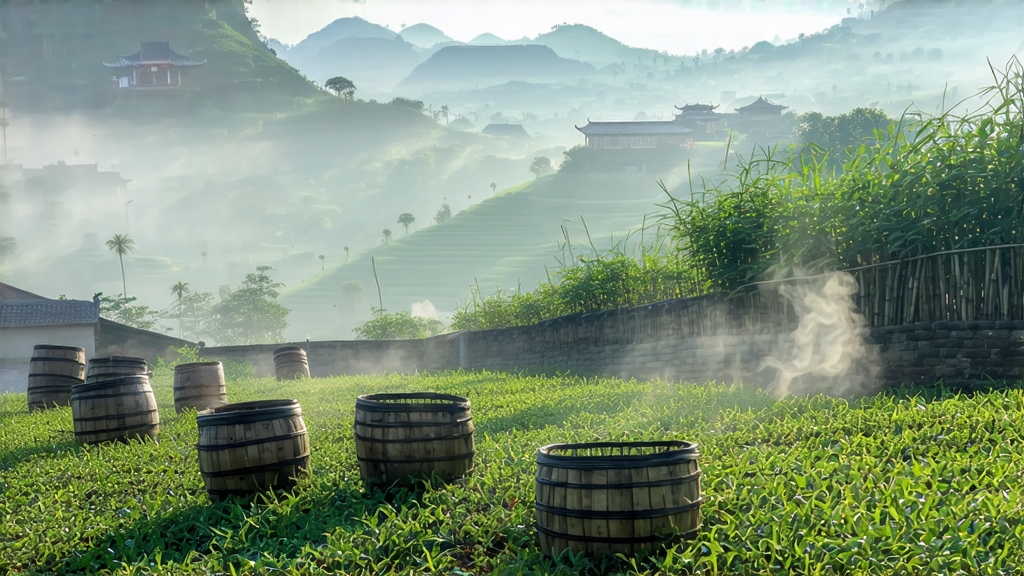
Liu Bao, literally “Six Forts,” is the quietest celebrity in the world of dark tea. While Pu-erh hoards the spotlight, this cousin from southern China has spent four centuries perfecting the art of subtlety, carrying the humid breath of the Guangxi mountains in every leaf. To understand Liu Bao is to listen to a story told in micro-organisms, trade winds, and the patience of farmers who once packed tea into coarse bamboo baskets and walked it to the docks of Wuzhou, believing the voyage would finish what the soil had started.
History: From Frontier Currency to Maritime Secret
The earliest written record appears in 1662, when the Qing government listed “Cangwu Liu Bao” as a medicinal tribute. Caravans moved the tea west into Yunnan and north along the Xiang River, but its greatest odyssey began when the British East India Company loaded it onto clippers bound for Malaya. In the tin mines of Kuala Lumpur, coolies drank it to ward off malaria; in Singapore, Peranakan brides steeped it thick and sweet as dowry tea. The British, puzzled by its “betel-nose” aroma, shipped it onward to Calcutta and Johannesburg, so that by 1906 Liu Bao had quietly circled the globe while still labelled only with a stencil of a single Chinese character: 茶. The tea became a currency of empathy—miners paid in bricks, doctors bartered for baskets—yet in its homeland it remained a rustic afterthought until the 2008 announcement of China’s intangible cultural heritage list suddenly anointed it as “the maritime silk road tea.”
Micro-Terroirs within One County
Liu Bao is not a single village but a constellation of micro-climates cradled between the Dayao and Yunkai ranges. The core is the basin around Liubao town, where red lateritic soil drains monsoon rain in minutes, forcing roots to dive three metres for minerals. North-facing slopes give “mountain cloud” style—slow growth, high theabrownin—while south-facing gardens yield “river mist” style, where leaves fatten on reflected humidity and ferment into darker sugars. Between them lie the terraced plots of Shuangqing, famous for “cinnamon-bark” veins that appear after five years of aging. Purists speak of three altitudinal bands: below 300 m for daily drinking, 300–500 m for collectors, and above 500 m for apothecaries who still prescribe it for “damp-heat.”
Craft: When Bamboo Baskets Become Wombs
Plucking follows the southern Guangxi calendar: one bud-three leaves before Qingming for fragrance, one bud-four leaves after Guyu for body. The moment leaves reach the factory, they enter a choreography unchanged since the Jiaqing era. First, two minutes of 280 °C wok-shafting kills green enzymes yet keeps leaf walls intact; next, rolling is done with the feet—workers tread barefoot on bamboo mats, their soles reading moisture like Braille. The real signature is the “pile-ferment in bamboo baskets”: leaves are heaped 70 cm deep inside cylinders woven from two-year-old mao zhu, then wheeled into a cellar whose walls weep with 85 % humidity. For fifteen days the tea breathes through the slats, absorbing lactobacillus native to the bamboo’s inner skin. When the core temperature hits 58 °C the pile is broken, re-steamed, and pressed by stone into 50 kg baskets lined with wild banana leaf. The bamboo is not packaging; it is a second fermentation vessel, slowly toasting the tea as trucks rumble toward humid warehouses in Wuzhou where the slow decades begin.
Aging Grammar: Humid, Hot, and Alive
Unlike Pu-erh’s dry Yunnan towers, Liu Bao demands tropical humidity. Ideal storage swings between 28 °C and 32 °C, with relative humidity kissing 80 %. In these conditions the tea trades chlorophyll for petrichor, catechins for theaflavins, and eventually produces a rare metabolite—6’-O-caffeoylarbutin—responsible for its cooling, throat-tingling finish. Connoisseurs read the brick as if it were tree rings: a golden halo on the edge means year five, camphor notes appear around year twelve, and the coveted “pine smoke dissolved into jujube” arrives only after two decades. The most sought-after lots are the “returned baskets”: teas that sailed